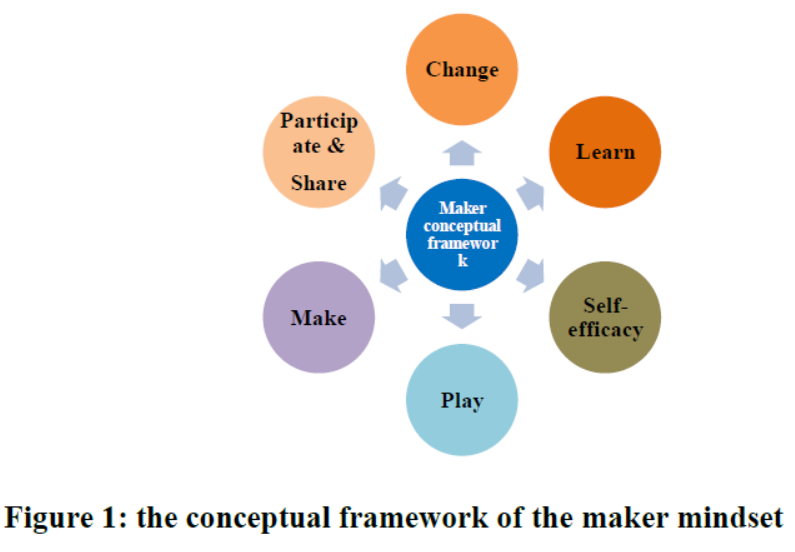Nurturing the Maker Mindset in Pre-Service Teachers: A Study of the Impact of a STEM Camps
Main Article Content
Abstract
This study investigates the impact of STEM camps on developing a maker mindset in pre-service science teachers. A total of 11 pre-service teachers participated in a 2-month fieldwork experience that included attending STEM camps three times and a debrief session. The Maker Mindset questionnaire was used to assess changes in the participants' maker mindset over the fieldwork experience. The STEM camp, based on a DIY tinker and maker framework, consisted of 13 activities that aimed to promote an understanding of STEM concepts and principles through experiential learning. The data indicated significant changes in several categories of the Maker Mindset questionnaire between the pre-STEM camp and post-STEM camp. Specifically, the level of "Change," "Learn," "Play," and "Make" increased, while the level of "Self-efficacy" decreased. These findings suggest that the STEM camp positively impacted the development of a maker mindset in pre-service science teachers. The findings also pointed that to promote the maker mindset in STEM camps effectively, it is important to address skills such as growth mindset, grit, and collaboration.
Article Details

This work is licensed under a Creative Commons Attribution-NonCommercial-NoDerivatives 4.0 International License.
References
Barrow, L., & Stepien, W. J. (2019). The impact of STEM education on student learning and career readiness. International Journal of Science and Mathematics Education, 17(1), 1-17.
Bleicher, R. E., & Lindgren, R. (2020). Impact of a STEM summer camp on pre-service teachers' maker mindset. Journal of Technology Education, 31(2), 10-23.
Buechley, L., & Peppler, K. A. (2014). The maker mindset: Empowering young people to shape their worlds. Phi Delta Kappan, 95(6), 22-27.
Chu, S. L., Quek, F., Bhangaonkar, S., Ging, A. B., & Sridharamurthy, K. (2015). Making the Maker: A Means-to-an-Ends approach to nurturing the Maker mindset in elementary-aged children. International Journal of Child-Computer Interaction, 5, 11-19.
Dixon, C., & Martin, L. (2014). Make to relate: Narratives of, and as, community practice. Boulder, CO: International Society of the Learning Sciences.
Duckworth, A. (2016). Grit: The power of passion and perseverance. New York, NY:Scribner.
Dougherty, D. (2013). The maker mindset. In Design, Make, Play: Growing the Next Generation of STEM Innovators. https://doi.org/10.4324/9780203108352
Duckworth, A. L., Peterson, C., Matthews, M. D., & Kelly, D. R. (2007). Grit: Perseverance and passion for long-term goals. Journal of personality and social psychology, 92(6), 1087–1101. https://doi.org/10.1037/0022-3514.92.6.1087
Dweck, C. S. (2006). Mindset: The new psychology of success. New York, NY: Random House.
Gerstein, J. (2016). Becoming a maker educator. Techniques: Connecting Education & Careers.
Halverson, E. R., & Sheridan, K. (2014). The maker movement in education. Harvard Educational Review, 84(4), 495-465. doi: 10.17763/haer.84.4.34w8j68140382063
Hatch, M. (2013). The Maker Movement Manifesto: Rules for Innovation in the New World of Crafters, Hackers, and Tinkerers.New York: McGraw Hill Professional.
Honey, M., & Kanter, D. E. (2013). Design, make, play: Growing the next generation of STEM innovators. New York, NY: Routledge.
Hsu, Y. S., & Wu, H. K. (2018). The effect of maker education on students' learning motivation and problem-solving ability: A meta-analysis. Journal of Educational Technology & Society, 21(2), 136-146.
Kabir, M. N., & Brewer, J. (2017). The Maker Mindset: A Case Study of a High School Maker Club. Journal of Pre-College Engineering Education Research, 7(1), 31-39.
Kapur, M. (2019). Making and unmaking: How and why making in education matters. Cambridge Journal of Education, 49(1), 5-20.
Kilinc, E., Bicen, H., & Okur, H. (2017). Investigating pre-service teachers' STEM learning through a STEM camp. Journal of Education and Learning, 6(1), 1-12. https://doi.org/10.5539/jel.v6n1p1
Klepper, J., Pereira, J., & Zayner, Z. (2017). Maker Education. Effective Implementation in 21st Century Classrooms.
National Science Board. (2018). Science and engineering indicators 2018. Arlington, VA: National Science Foundation.
Martin, L. (2015). The Promise of the Maker Movement for Education. Journal of Pre-College Engineering Education Research (J-PEER). https://doi.org/10.7771/2157-9288.1099
Martinez, S. L., & Stager, G. (2013). Invent to learn: Making, tinkering, and engineering in the classroom. Torrance, CA: Constructing Modern Knowledge Press.
Myers, N. (2017). What is a maker mindset? StemMinds. Retrieved on August 29, 2018 from: https://stemminds.com/what-is-a-maker-mindset/.
Pierrat, J. (2016). 6 Must-Haves for Developing a Maker Mindset. Retrieved from https://www.edsurge.com/news/2016-06-06-6-must-haves-for-developing-a-maker-mindset (17) (PDF) Bridging distance: Practical and pedagogical implications of virtual Makerspaces. Available from: https://www.researchgate.net/publication/342312568_Bridging_distance_Practical_and_pedagogical_implications_of_virtual_Makerspaces
Pocock, J. (2016). Maker Movement 2.0. ASEE Prism, 26(3), 34-37.
Smith, B., & Grady, W. (2016). The maker mindset: Empowering learners to shape their world. Alexandria, VA: ASCD.
Turan, Z., Karasoy, H., & Akkoc, H. (2020). The impact of a STEM camp on the development of STEM-related skills of pre-service teachers. European Journal of Education Studies, 7(3), 178-191. https://doi.org/10.5281/zenodo.3734089
U.S. Department of Commerce. (2019). STEM education: Building a strong workforce for the 21st century. Washington, DC: U.S. Department of Commerce.
Weaver, S., Stirling, K., Norman, K., & Jackson, S. (2021). Impact of a week-long maker camp on high school students' self-efficacy and attitudes toward STEM. Journal of STEM Education: Innovations and Research, 22(2), 23-32.


